Petrichor is back on Kickstarter with a new Cows expansion!
If I’ve said it once, I’ve said it a thousand times — a unique theme can sell a board game to me in a heartbeat. With that said, I’m ashamed to say that I’d never really heard of Petrichor before I took on this review. Now that I have, however, I can safely say that I have rarely been so blown away by the strength of the link between the mechanics and theme of a game as I am by this unique gem.
First things first, the reason for this review, right now, is because Petrichor (which has been out for a while) has just been relaunched on Kickstarter. The reason? Well, a third “small box” expansion is being added, which will build upon the base game, plus the existing Flowers and Bee’s expansions.
We’ve been lucky enough to have received a near-final production copy of the new expansion (known simply as Cows) as well as a copy of the base game and the existing expansions. This review will take into account the full experience of playing Petrichor, with a specific section at the end which will call out the new features that Cows introduces. You can view it on Kickstarter now.
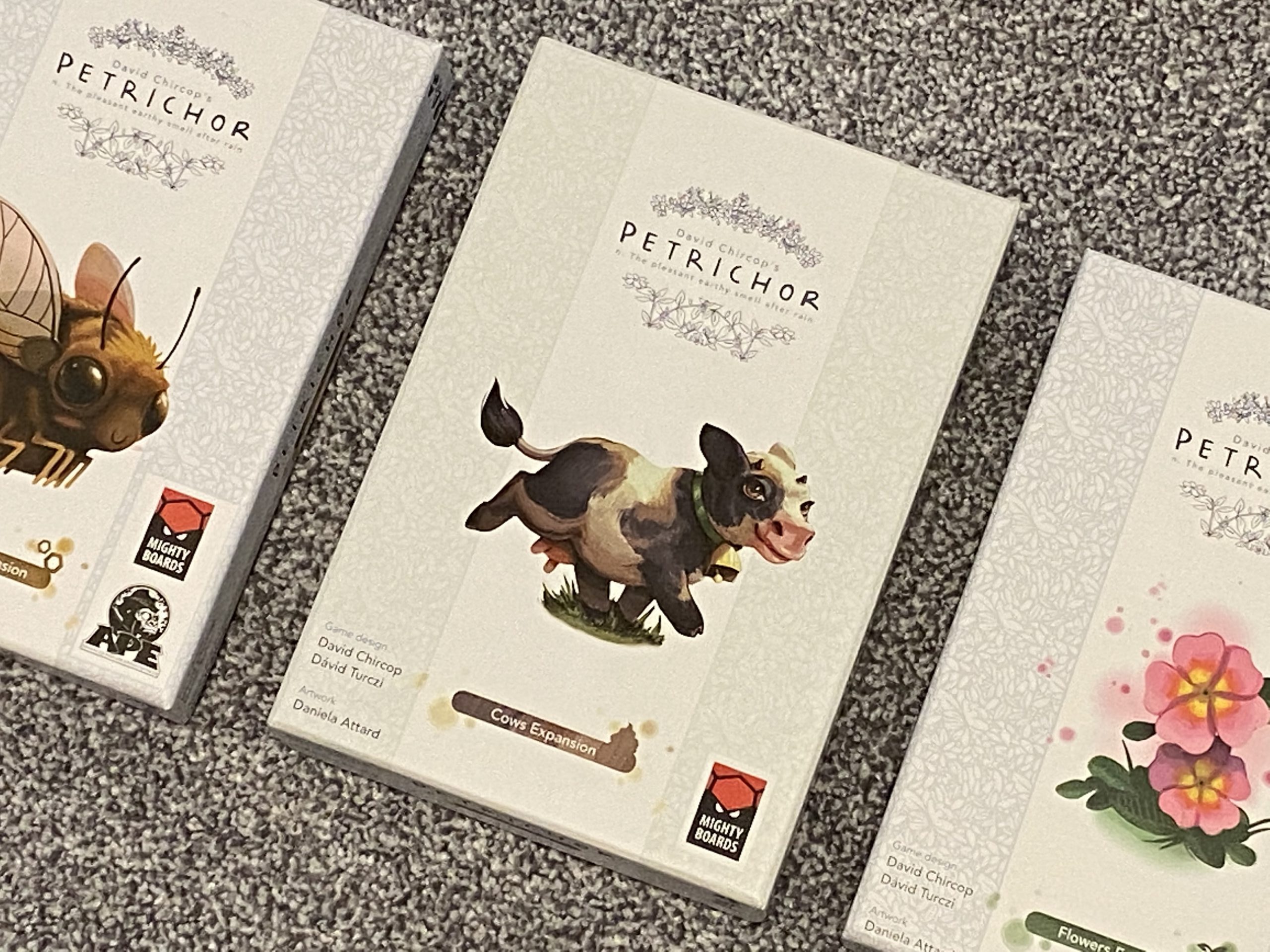
Starting from the top, Petrichor is the kind of game that makes you feel clever as you play it, because it has the kind of sciencey, real-world-theme that makes you feel like you’re doing real-life-stuff. Of course, you’re not, but for the purpose of giving players a feeling of smugness and potentially educating and piquing the interest of bright, young players, Petrichor has what you need.
The concept — and the meaning of the word petrichor — is simple. This is a game about rainfall, with petrichor literally meaning “the pleasant smell following rainfall on dry ground” which is very much a reflection of the gameplay. This is an area control game in essence, but it’s played from the perspective of controlling raindrops, and despite that very gentle, innocuous theme, it is, without doubt, one of the meanest games I’ve played this year.
The objective of the game is to score the most points over four or six rounds depending on whether you play a long or short game. Either way, Petrichor tops out at no more than two hours, but the average long game came in at about ninety minutes with two or three players, which for me meant that the short game was never really needed.
Points are scored primarily by getting raindrops of your colour to fall onto the plants and trees that grow in the randomised grid of tiles that you’ll set up at the beginning of the game. The timing of when you want your rain to fall and the amount of it can vary quite a bit, however, with even the simplest plants scoring points in interesting ways — and in very few cases is it as straightforward as most rain wins.
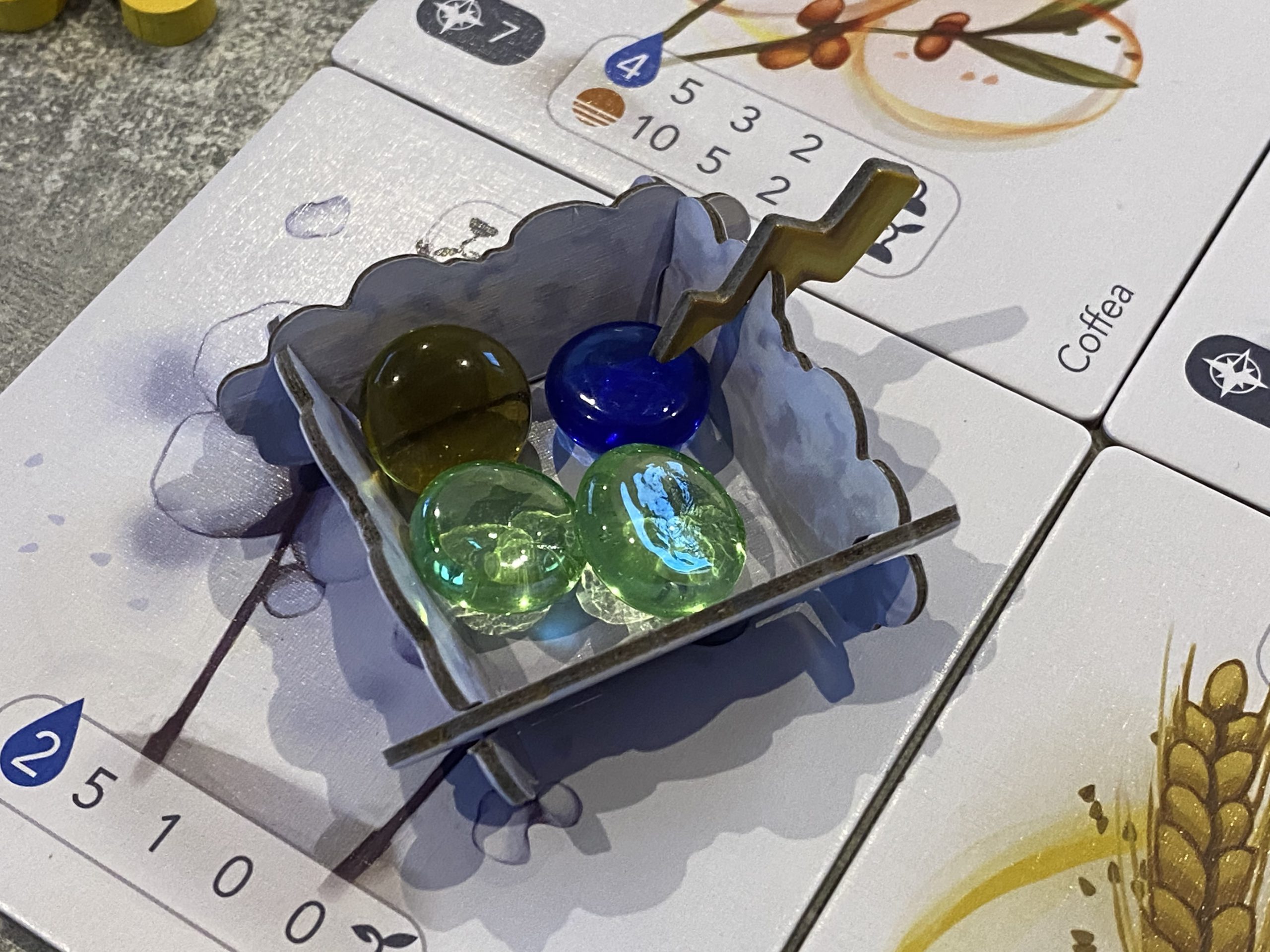
It’s a little hard to describe what you’ll actually see when playing Petrichor since it sounds so bizarre, but in short, you’re going to be placing clouds onto the board, then filling them with raindrops of your colour. Under certain circumstances these clouds will either move, change or burst, and this is how you’ll end up with your raindrops on the plants. Rain will also trigger plants to grow, whilst on some rounds, a harvest will trigger, which is when the players will score their rainfall. For all this to make sense though, you’ll need to understand the game in a bit more detail.
Each of the four or six rounds in a game of Petrichor is split into four phases, which include the Action Phase, the Weather Phase, a Harvest Phase (only if triggered) and the Cleanup Phase. Most of the time you’ll spend during the game will be in playing actions, and you can take one or two actions exactly.
To take your first action, you’ll take one card from your hand and play it, then you’ll take the action associated with the image shown. Frost allows you to add a new cloud with one raindrop in it, whilst sun allows you to add two raindrops to an existing cloud in which you have a presence already. Wind moves a cloud, whilst rain allows one single raindrop to fall onto the crop below.
Now, if you want to take a second action, you can do so, but if you do, you’ll need to pay two cards of the same kind to take the action. Whether it is your first or second action, you may always substitute any two cards for one of another kind. As an example, you might want to take the wind action twice, which will cost a minimum of three wind cards, but it might cost as much as six of any card combination — two for the first action, then four on the second.
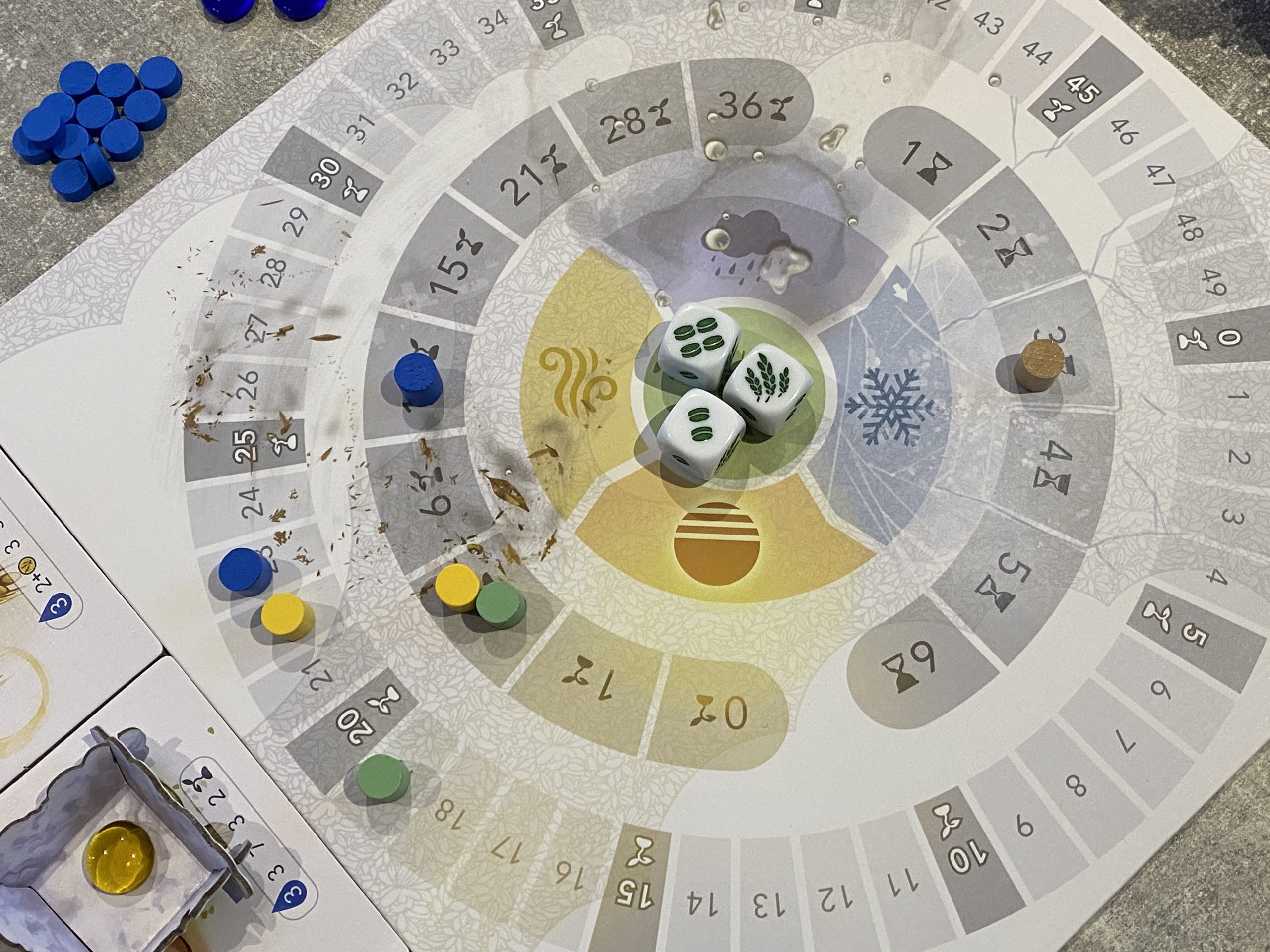
You’d only do the latter, of course, if you were desperate and you had a good reason to do so, because the Action Phase does rotate around the players for as long as players want to keep taking actions. You can therefore take up to seven actions as long as you’re prepared to do them one at a time, and you can play the cards you’ve been dealt.
Aside from the actions I’ve described above which manipulate the clouds and raindrops, each action will also allow you to either take a vote or change the harvest dice (and take a point) on the main board. The player will place one of their voting tokens onto either the season that matches the weather card they played (sun for summer, frost for winter, etc) or the following season and the two “most popular” seasons will take effect in the Weather Phase that follows the Action Phase once it ends.
At the end of the game, there will be a scoring event based on how well each player has aligned themselves to the successful votes. Bearing in mind that during each Weather Phase, only two seasons, only the most popular two seasons will take effect, so only those will add to a players score here. Should a player choose not to vote and instead to change one of the harvest dice, then they may do so, and will take one single victory point as well.
The different seasons that take place in the Weather Phase all have their own effects that broadly align to those in the Action Phase, but arguably they are more powerful because they happen less frequently. During Winter, light clouds become thunderclouds, in Spring, all thunderclouds rain and so on. With these effects done, the harvest dice are checked. If all three happen to be showing the harvest symbol, then a Harvest Phase will be triggered.
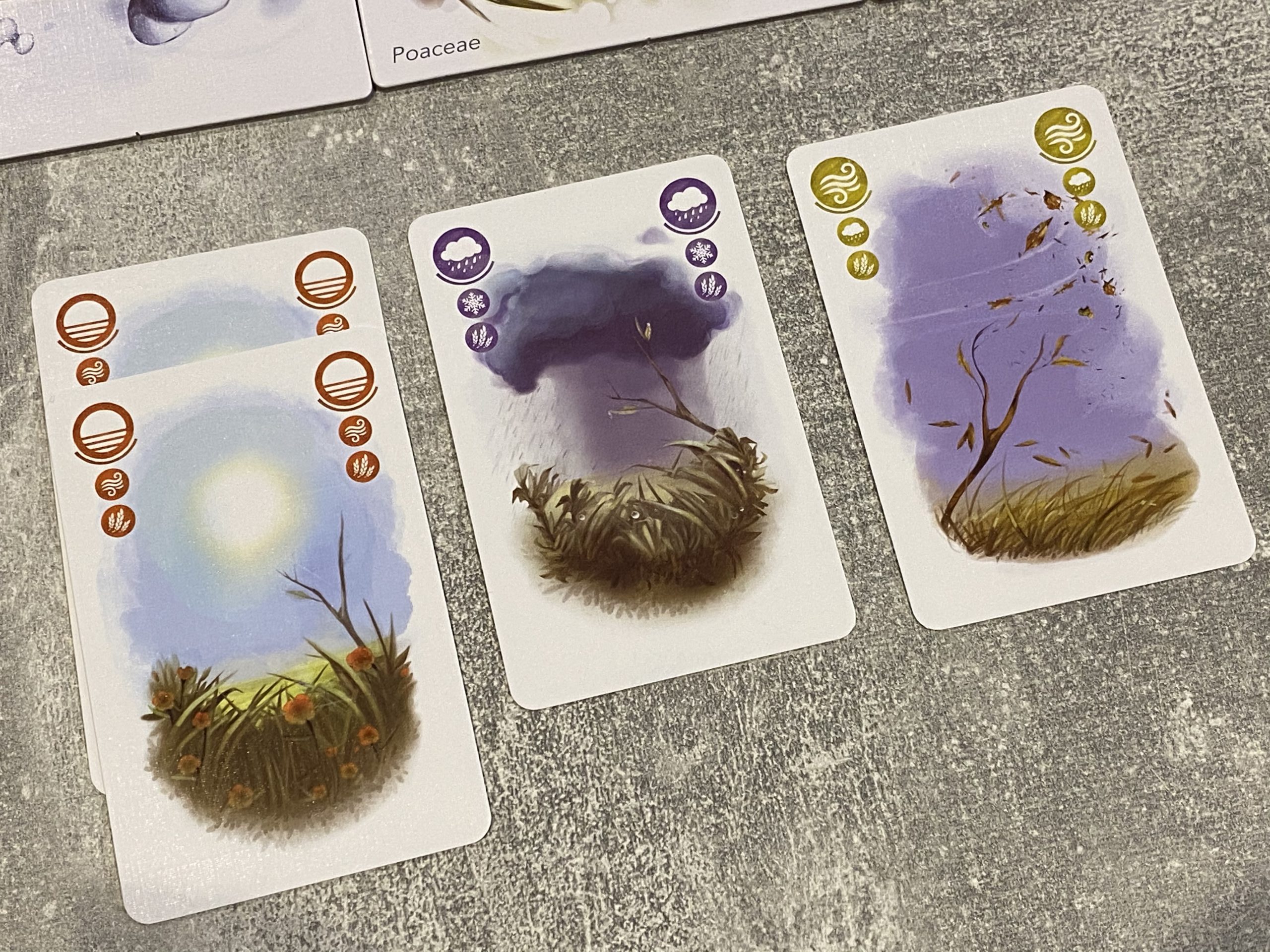
A Harvest Phase is essentially just a scoring phase, and it’s a really nice feature of Petrichor that you might have a single Harvest Phase (at the end of the game) or potentially as many as seven (albeit very unlikely) and this is pretty much entirely in the hands of the players. It is certainly possible that the initial die roll and the number of players (and thus the number of actions that affect the dice) might prevent this, but it allows players to take one of several strategies to suit them.
When a Harvest Phase is triggered, every tile that has a plant symbol on it will be scored. Plant symbols appear to indicate that a plant is growing, and these are placed as soon as the number of raindrops shown lands there. The interesting thing is that the board state at the time of growth is not normally relevant to scoring, but it is relevant at the time of harvesting.
For example, a potato plant will score the most points for the player who has the second most raindrops on it, whilst wheat will give one more point for second, but it will also give a wheat token to the player with most, and the wheat majority (at the end of the game) is worth a decent amount of points as well.
Now I won’t spend too much time talking about Flowers and Bees here, but I do want to mention that the wheat and potato examples above are easily among the most straightforward plants to score. With flowers, a raft of new and more complex plants are included, whilst with Bees a giant honeybee token is introduced, with a focus on pollinating various fruit trees.
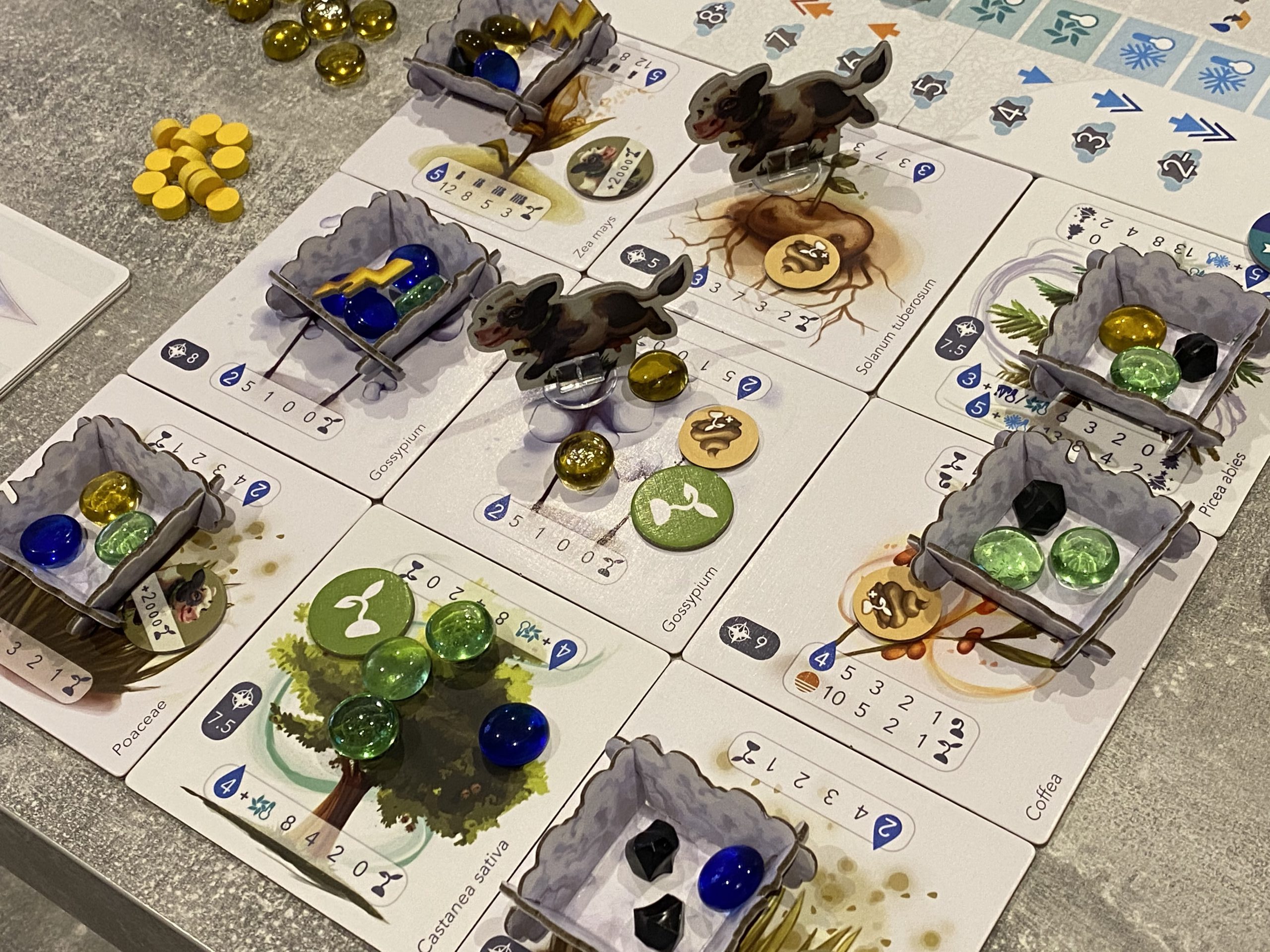
I should also mention that whilst I’ve literally just said that the time of growth generally doesn’t matter, it actually does in the new Cows expansion, depending on which plant tiles you have in use. In particular, some of the new plants (trees actually) have their growth tied to a new temperature board that actually promotes or stifles growth depending on the environmental situation.
On that note, the other addition in the Cows expansion, funnily enough, is a couple of cow standees and a whole lot of methane. Methane now adds itself to clouds and can cause unpredictable effects and affect the temperature. Players can manipulate methane to either make clouds burst in their favour, or to allow methane to escape into the atmosphere in a way that might scupper their opponents.
Conscious as I am that this review may now run into a fourth page, I should mention a couple of observations about Petrichor and why I really enjoyed it. Firstly, whilst it might sound quite complex to play, the game actually works in a very logical way, and the weight is very much based on the decisions, rather than the base mechanics. Teaching Petrichor is pretty easy given the depth of decisions you’ll be making, and whilst it isn’t a gateway game, it’s simple enough that relative novices can learn it.
One thing to bear in mind however is that Petrichor is really, genuinely mean. You’ll blow your friends clouds into rubbish places, you’ll burst them at inopportune times and then you’ll pour down on their plants to try and mess up their scoring potential. You’ll trigger the Harvest when no one wants it, and you’ll spoil vote after vote!
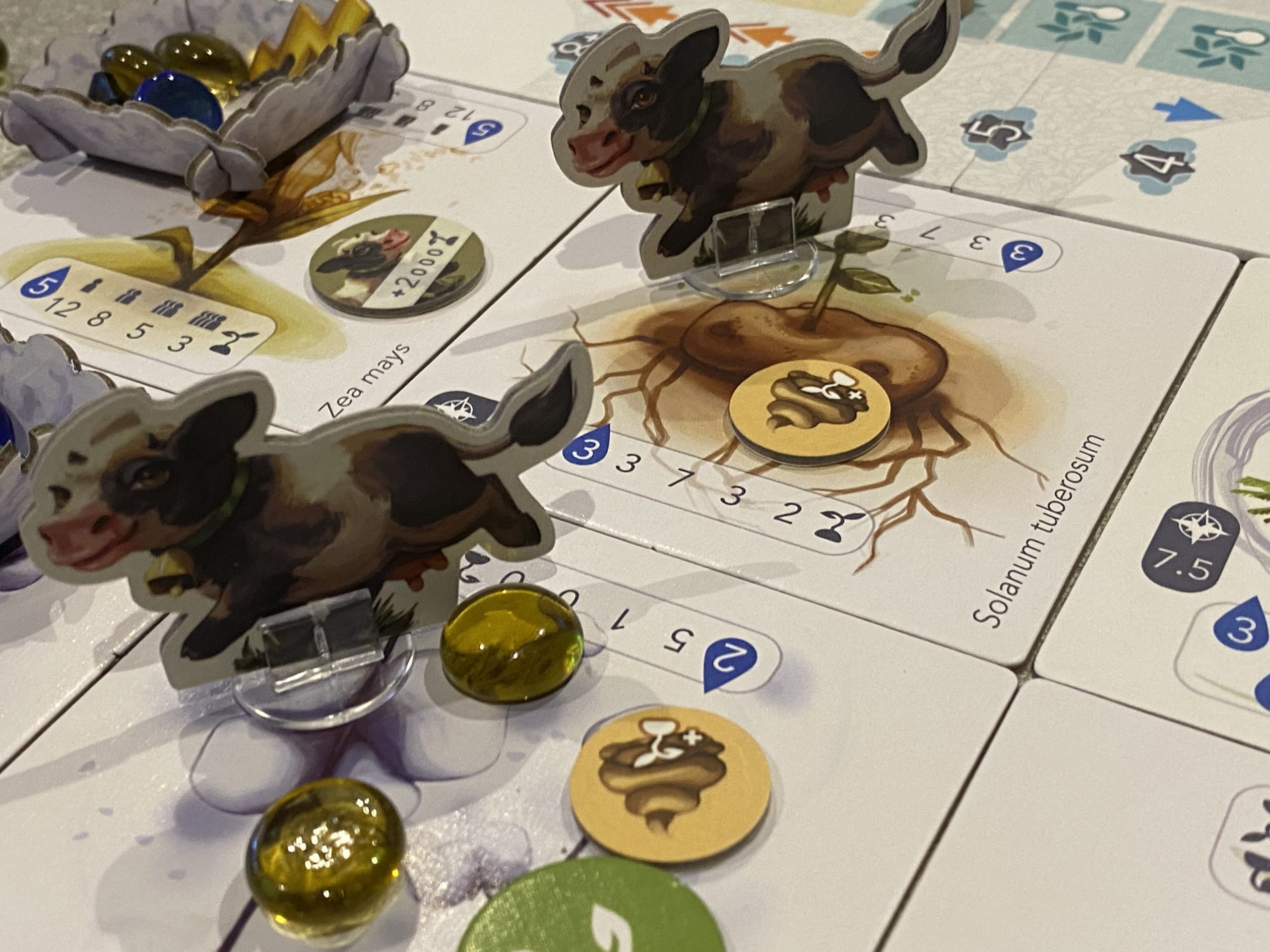
With each of the expansions in play, you can play with up to five players and you’ll have a lot more plants and variations (honeybees and cows) than you’ll ever really need, but it does feel to me like Petrichor works best as a “complete” experience. The base game is fantastic and I’ve really enjoyed it, but the variety that the expansions introduce is necessary after a few plays, but it’s never groundbreaking.
Methane and the temperature board, for example, really do change the game, but they don’t add too much in the way of new mechanics. I could possibly argue that the need for a temperature board is a bit elaborate seeing as it doesn’t affect every plant (and the number of Cow expansion plants you’ll use is probably going to be two in most cases) but it’s very easy to manage in all fairness.
Overall, I feel confident enough about the staying power of Petrichor that I can recommend players who have any interest in the subject matter or the idea of a deep and very competitive area control game should dive straight in. Like all Mighty Boards productions, Petrichor is exceptionally well made, and in addition to being very solid, it also looks fantastic on the shelf and on the table. Highly recommended.
You’ll be able to find Petrichor over on Kickstarter shortly.
Love board games? Check out our list of the top board games we’ve reviewed.
Comments are closed.